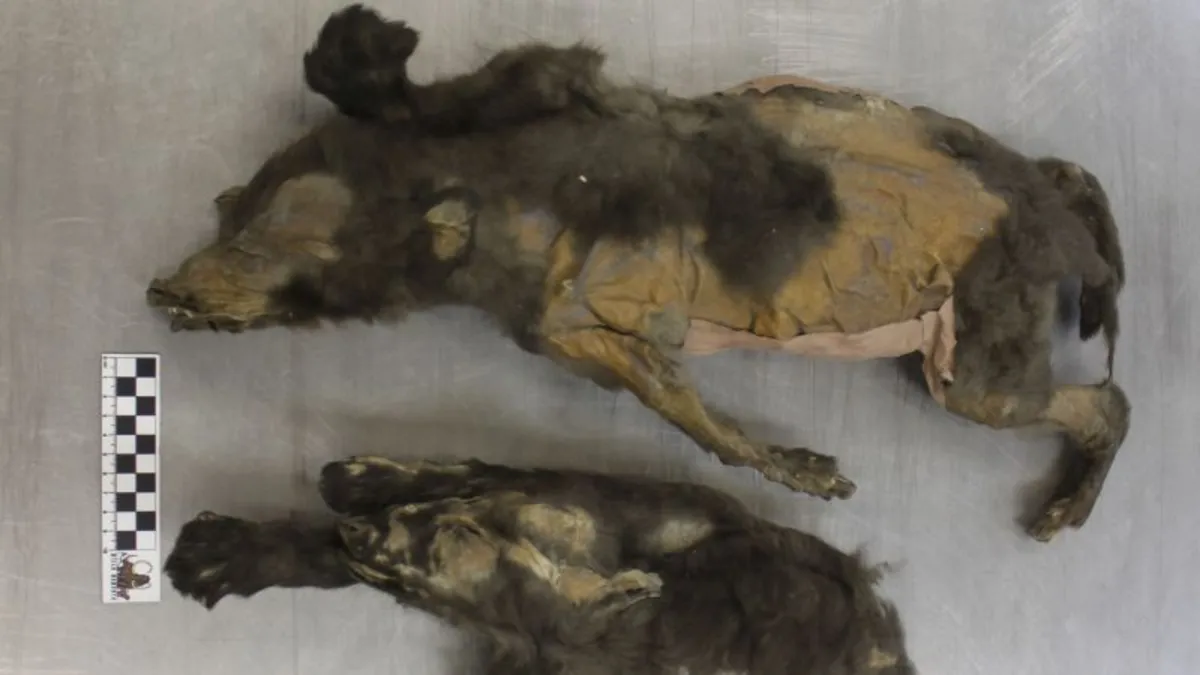
Explore the universe with updates on fascinating discoveries, scientific advancements, and more! Stay informed about the latest in science with CNN's Wonder Theory science newsletter.
Two remarkably preserved ice age “puppies” found in Northern Siberia are prompting a reevaluation of their identity. Research indicates that these ancient specimens, known as the Tumat Puppies, may not be domesticated dogs as previously believed. These puppies, still covered in fur and preserved in ice for thousands of years, were discovered with remnants of their last meals, which included meat from a woolly rhinoceros and feathers from a small bird called a wagtail.
Initially thought to be early domesticated dogs or tamed wolves that cohabitated with humans, the remains of the Tumat Puppies were unearthed near woolly mammoth bones that showed signs of human interaction, such as burning and cutting. However, recent genetic analyses of the puppies’ gut contents, alongside chemical signatures found in their bones, teeth, and soft tissue, suggest that these animals were actually two-month-old wolf pups. Notably, there is no evidence indicating that they interacted with humans, as detailed in findings published in the journal Quaternary Research.
Believed to be sisters, neither of the mummified wolf cubs displayed any signs of injury or attack. This suggests they met a sudden demise when their underground den collapsed, likely due to a landslide, over 14,000 years ago. The richness of data derived from these remains is providing insights into the daily lives of ice age animals and their dietary habits, which closely mirror those of contemporary wolves.
“Finding two sisters from this era so well-preserved is incredible; even more astonishing is the wealth of information we can extract about their lives, including details about their last meal,” stated Anne Kathrine Wiborg Runge, the lead study author and former doctoral student at the University of York and the University of Copenhagen.
The Tumat Puppies were discovered separately at the Syalakh site, located approximately 25 miles (40 kilometers) from the nearest village of Tumat—one was found in 2011 and the other in 2015. These specimens are estimated to be between 14,046 and 14,965 years old. Under optimal conditions, hair, skin, and even stomach contents can remain intact for millennia, according to Dr. Nathan Wales, senior lecturer in archaeology at the University of York.
Runge expressed her surprise at the discovery of the second Tumat Puppy years after the first, remarking, “It is exceptionally rare to find two specimens that are so well preserved and also turn out to be siblings.”
Similar to modern wolves, the Tumat Puppies consumed both meat and plant matter. A piece of woolly rhinoceros skin found in one pup’s stomach confirms their diet. This skin, which still bore blond fur, was only partially digested, indicating that the pups likely died shortly after their last meal. Previous research on juvenile woolly rhinoceros specimens found in permafrost suggests that the fur color aligns with that of a calf. The study authors propose that an adult wolf pack hunted the calf, bringing it back to the den to feed the puppies.
“The hunting of an animal as large as a woolly rhinoceros, even a calf, suggests that these wolves might have been larger than today’s wolves,” Wales noted.
The analysis of tiny plant remains found in the cubs’ stomachs revealed that they inhabited a dry, moderately mild environment capable of supporting diverse vegetation, including prairie grasses and willow shrub leaves. In addition to solid food, the pups were probably still nursing milk from their mother, the researchers concluded.
Interestingly, no evidence was found indicating that mammoths were part of the cubs’ diet, suggesting it was unlikely that humans were directly feeding them. While the possibility of humans sharing woolly rhino meat with the cubs was considered, Wales leans toward the interpretation that the puppies were primarily fed by their adult wolf pack.
Reconstructing the dynamics between ancient wolves and humans remains challenging due to the absence of written records or cave art of that era. “We must account for our biases and preconceived notions based on current human-wolf interactions,” Runge stated. Researchers are still exploring how domesticated dogs became companions to humans. One hypothesis suggests that wolves scavenged near human settlements, while another posits that humans actively captured and raised wolves, eventually leading to the domestication process.
Previous DNA tests on the Tumat Puppies hinted they might belong to an extinct wolf population that did not interbreed with modern dogs. “When discussing the origins of dogs, we refer to the first domesticated animal, necessitating solid evidence to support claims about early dogs,” Wales explained.
The quest to pinpoint when and where dogs were domesticated continues to be a significant challenge in archaeology and evolutionary biology. As Dr. Linus Girdland-Flink, a lecturer in biomolecular archaeology, noted, determining whether ancient remains like the Tumat Puppies represent early domestic dogs, wild wolves, or tamed individuals is complex due to the fragmented archaeological record.
“No single piece of evidence can provide a definitive answer; we must integrate various lines of evidence—archaeological, morphological, genetic, and ecological—to form a comprehensive understanding,” Girdland-Flink emphasized.
Overall, the findings surrounding the Tumat Puppies highlight the complexity of early human-animal interactions and the significance of these ancient remains in unraveling the mysteries of our past.